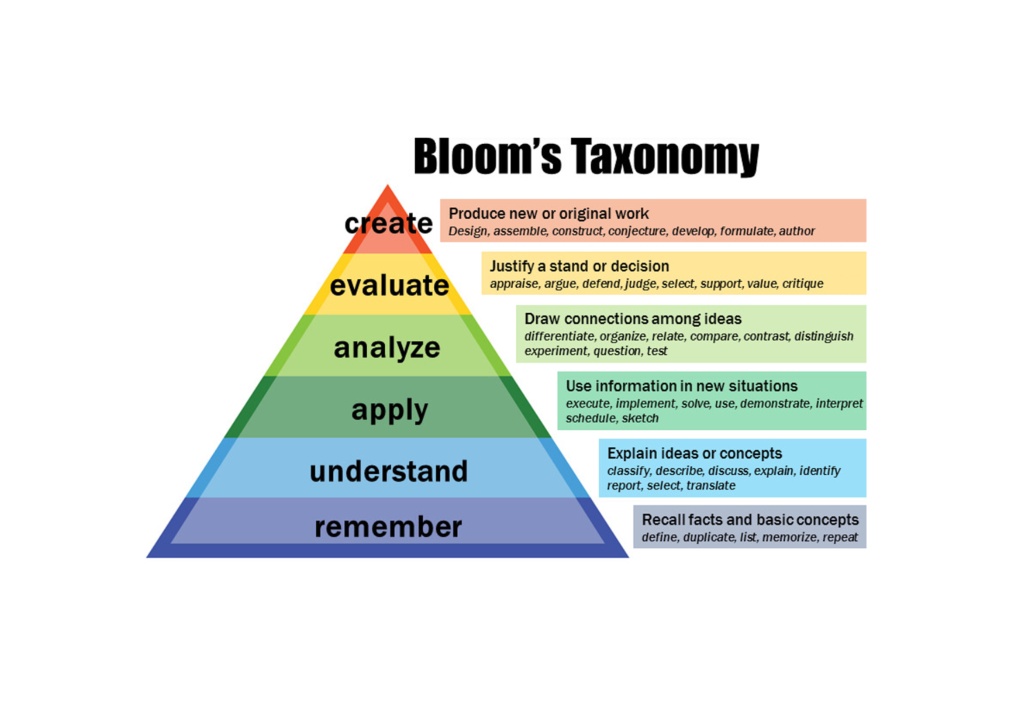
The Bloom’s Taxonomy Instructional Design Model in E-Learning – An Introduction
The Bloom’s Taxonomy Instructional Design Model in E-Learning – An Introduction
This is the second blog in our series looking at the main instructional design models that are used in e-learning. In this article, we are going to explore Bloom’s Taxonomy, a well-established framework in the education sector. We are going to focus on its relevance in e-learning, particularly in regard to the training and development of staff in companies in the UAE and Saudi Arabia.
What is Bloom’s Taxonomy?
Bloom’s Taxonomy was originally published in 1956, although the current and most popular iteration is an updated version published in 2001.
Bloom’s Taxonomy defines the broad levels of learning. There are six levels, where learners achieve competence in each level before they can progress to the next.
The six levels of Bloom’s Taxonomy are:
- Remembering
- Understanding
- Applying
- Analysing
- Evaluating
- Creating
The practical use applications for Bloom’s Taxonomy involve progressing learners beyond the basic components of learning – remembering and understanding. The aim is to help learners achieve a higher level of learning, where knowledge and skills are put to practical use. The higher levels of Bloom’s Taxonomy are also about fostering innovation, improving decision-making, and enabling critical thinking.
What is Bloom’s Taxonomy Used For?
Bloom’s Taxonomy is used as an instructional design model, i.e., it is a framework for the e-learning development process. It is particularly useful when defining learning objectives. As learning objectives are an essential part of instructional design, Bloom’s Taxonomy helps ensure the courses you create meet the needs of learners and the goals of your business.
It also helps give you a better understanding of how well your training courses are performing.
Implementing Bloom’s Taxonomy
In the above description of Bloom’s Taxonomy, we talked about how the six levels are dependent on each other. For example, a learner must remember the concept or information before they can fully understand it.
While this is true, it doesn’t mean that all learners will always start at the bottom level. There are situations where learners will already have the foundations of a topic, including remembering, understanding, and, often, applying. The objective and content of e-learning courses in these situations should be to help learners progress through to the higher levels of Bloom’s Taxonomy: analysing, evaluating, and creating.
We can now look at each of the six levels in more detail, including how to use e-learning and real-world examples of where the levels often apply.
Remembering
Remembering is the main foundational level of Bloom’s Taxonomy. It involves learners retaining information, facts, and knowledge.
In e-learning course development, it is important to present information to learners in a way that helps them to remember. Text, images, videos, and animations are all important e-learning tools that will help learners remember. Quizzes are another useful feature.
Examples of learning outcomes for the remembering level of Bloom’s Taxonomy include recalling company procedures and being able to recite product features and prices.
Understanding
Remembering something is not the same as understanding it. The understanding level of Bloom’s Taxonomy is about moving beyond remembering information to a point where learners understand what the topic means in practice.
To develop understanding, you need to make the content in your e-learning course relevant to learners.
Examples of learning outcomes for the understanding level include being able to summarise, explain, or compare the topic.
Applying
The aim of almost all e-learning courses is to change behaviours, whether that is putting a new skill to use or altering existing working practices. This is the objective of the applying level of Bloom’s Taxonomy.
Scenarios are a helpful e-learning tool at this level, as scenarios give learners an opportunity to apply what they have learned.
Examples of learning outcomes for this level include being able to use a software application or follow a procedure.
Analysing
Analysing is about getting a deeper understanding of the topic, where learners can evaluate information, compare concepts, and find relationships between complex ideas.
Scenarios are again a helpful e-learning tool with this level of Bloom’s Taxonomy, particularly complex scenarios. Other helpful tools include questions and features that get learners to break down a process into its component parts.
Examples of learning outcomes for this level include being able to make the right decision in complex situations or being able to determine the root cause of a problem.
Evaluating
This stage of the learning process involves learners being able to develop new ideas and suggestions. The ability to take complex decisions is another outcome of the evaluating level of Bloom’s Taxonomy.
In terms of the e-learning tools that are helpful at this level of Bloom’s Taxonomy, all those mentioned previously apply. The difference when learners reach this level is the complexity of the information that is presented and the challenges that are set.
An example of a learning outcome from the evaluating level is the ability to decide on and then justify a course of action in a subjective situation where there is no clear direction to follow.
Creating
This stage of the learning process involves the learner being able to use their skills and knowledge to develop new products, services, systems, solutions, processes, workflows, or training courses.
Again, all the aforementioned e-learning tools apply. At this level of a learner’s progression, it is about providing the learner with opportunities to develop their own strategies, ideas, content, processes, etc.
Examples of learning outcomes at this level include writing new strategy documents or developing a new process that improves productivity.
Holistic Approach
To maximise the benefits of Bloom’s Taxonomy, you should go beyond e-learning. All the e-learning approaches described above are relevant, but things like mentorships and on-the-job learning are also helpful.
Whatever the approach, Bloom’s Taxonomy provides an ideal e-learning framework for bringing learners up to the required level of competency.